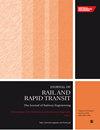Exploring hydrogen fuel cell and battery freight locomotive options using train dynamics simulation
IF 2.1
4区 工程技术
Q3 ENGINEERING, CIVIL
Proceedings of the Institution of Mechanical Engineers Part F-Journal of Rail and Rapid Transit
Pub Date : 2023-03-31
DOI:10.1177/09544097231166477
引用次数: 2
Abstract
As efforts are being made to quickly adopt zero carbon technologies and replace fossil fuel powered trains, the design requirements are explored using train dynamics simulations to establish energy needs. The test case was a freight train of 3030 gross tonnes consisting of two locomotives and thirty wagons operating on a relatively flat coastal rail route. Then, assuming rapid deployment of existing and near market technologies, speculative locomotive designs are proposed for both battery only and hydrogen-battery systems. Batteries were assumed as rack mounted systems and hydrogen assumed at 250 bar gaseous. The results showed that full recovery of dynamic braking required only a very small amount of storage to capture and allow re-use, requiring a battery of only 6% of the trip total of recovered energy. The haulage task was found to require traction energy of 10.7 MWh per locomotive but reduced to a net requirement of 7.6 MWh per locomotive with recovery of dynamic braking energy. The large mass of batteries needed for the operating trip, however, limits the practical operating range. The results showed that, although hydrogen storage and equipment occupy considerable space and the containment systems have large mass, the space and mass requirements for a hydrogen system in this case study could be as low as half that required for batteries, while higher pressure or cryogenic approaches to hydrogen storage will allow the scaling for longer range.利用列车动力学仿真探索氢燃料电池和电池货运机车的选择
随着人们努力迅速采用零碳技术并取代化石燃料动力列车,利用列车动力学模拟来探索设计要求,以确定能源需求。测试用例是一列总重3030吨的货运列车,由两台机车和30节车厢组成,在一条相对平坦的沿海铁路线上运行。然后,假设现有的和接近市场的技术快速部署,提出了纯电池和氢电池系统的机车设计。电池假定为机架安装系统,氢气假定为250巴气体。结果表明,完全恢复动态制动只需要非常少量的存储来捕获并允许重复使用,只需要电池回收总能量的6%。研究发现,运输任务需要每台机车10.7兆瓦时的牵引能量,但随着动态制动能量的回收,每台机车的净需求减少到7.6兆瓦时。然而,操作行程所需的大量电池限制了实际操作范围。结果表明,尽管氢气储存和设备占用了相当大的空间,并且密封系统具有很大的质量,但在本案例研究中,氢气系统的空间和质量要求可能低至电池所需的一半,而更高的压力或低温方法将允许扩展更长的范围。
本文章由计算机程序翻译,如有差异,请以英文原文为准。
求助全文
约1分钟内获得全文
求助全文
来源期刊

CiteScore
4.80
自引率
10.00%
发文量
91
审稿时长
7 months
期刊介绍:
The Journal of Rail and Rapid Transit is devoted to engineering in its widest interpretation applicable to rail and rapid transit. The Journal aims to promote sharing of technical knowledge, ideas and experience between engineers and researchers working in the railway field.
 求助内容:
求助内容: 应助结果提醒方式:
应助结果提醒方式:


